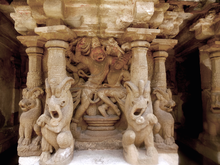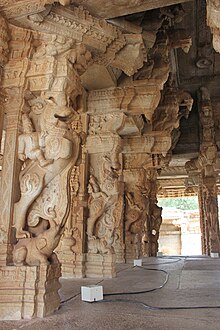Yali (mythology)
The term Yali ( Sanskrit : Vyala or Vidala ), which is mainly used in the South Indian languages, denotes a hybrid being ( Chimera ) consisting of lion , horned animal, elephant etc. In northern India the term Vyala is more common for a lion-like being. Another Sanskrit word ( sharabha or sarabeswara ) means a hybrid of lion and griffin ('Leogryph').
history
Yalis or Vyalas seem to have their origins in ancient Greek or Persian cultures. In India they first appear in older literature, but only since the early Middle Ages have they become widely used as a royal emblem or as a sovereign and disastrous ( apotropaic ) element on temple pillars. Important in this context is the Kailasanatha Temple (around 700) in Kanchipuram , the old capital of the Pallava Empire, where they appear in many ways. From India these beings also conquered other cultural landscapes in Southeast Asia.
presentation
The head of the Yalis is mostly lion-like; their body is often that of a rearing horse and their paws are often that of a bird. In some cases they hold the end of their serpentine tail in their mouths; in other cases their nose is elongated in the shape of a trunk. Almost all of them are depicted in a rearing posture, suggesting a certain aggressiveness. Sometimes riders are on their backs, which barely tames their aggressive nature.
The Vyalas of Northern India, on the other hand, are generally more lion-like; their four clawed paws often touch the ground - only sometimes they rear up. There is usually a small person around them who tries to kill them with a dagger or sword. This representation has become the emblem of the Chandella dynasty Khajuraho and the Hoysala dynasty in Karnataka .
Yalis on elephants, Ikkeri
Yalis on other hybrids, Kolar
Vyala and human, Banavasi
Vyala and man, Lakshmana Temple , Khajuraho
Vyala and man, Kandariya Mahadeva Temple , Khajuraho
symbolism
Yalis or Vyalas impress with their strange appearance and their untamed wildness. It is not uncommon for them to stand on the back of small elephants, which underlines their superiority. In them the demonic powers and forces of the early days seem to live on, which pose an incessant threat to human beings.
Others
"Yali face" ( Yali mukha ) is the name of the artfully carved curved end behind the pegbox of stringed instruments such as vina and gottuvadyam .
See also
Web links
- Yali - Photo + Info (English)
- Yali and Mukha - short information (English)
- Yali, etymology etc. (English)
- goat-legged Leogryph from Bihar - photo
- Yali as a symbolic animal of weapons (English)







